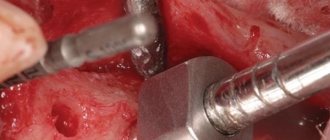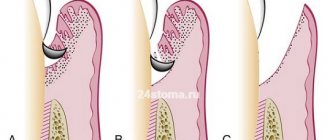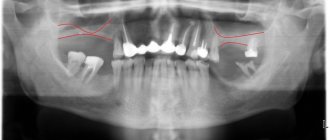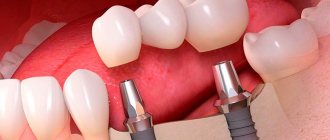Implantation is the replacement of a lost tooth with an artificial one. For an implant to function like a natural tooth, it must be securely secured. Unfortunately, as soon as we lose a tooth, the bone tissue begins to decrease. Over time, the atrophy becomes so pronounced that there is simply nowhere to insert the metal pin; there is not enough space for it.
In the upper jaw, bone loss is accompanied by a descent of the maxillary sinus membrane. As a result, there is not enough bone volume, and there is also a risk of membrane perforation during surgery.
Dentists have developed a bone grafting method that lifts the wall of the maxillary sinus. They called it sinus lifting, from the words “sinus” (maxillary sinus) and “lift.”
How it's going
Sinus lifting and implant installation are possible with open and closed methods. Whatever method the doctor chooses, it all starts with preparation. The implantologist assesses your general health and treats your gums if necessary. Blood tests make it possible to rule out infections and inflammatory processes. It is important to tell your doctor about allergic reactions.
A panoramic image (orthopantomogram) and CT will help assess the condition of the jaw, indications for implantation and augmentation. Installation of implants immediately after sinus lift is possible if the bone thickness is 5 mm or more. A CT scan will also show the presence of inflammatory processes in the maxillary sinus, cysts or tumors for which surgery cannot be performed.
Limitations after sinus lift and implant installation
Temporarily after simultaneous bone grafting and installation surgery, you must avoid:
- a hard toothbrush,
- hard and hot foods,
- baths and saunas,
- flights,
- physical activity,
- alcohol,
- cigarettes.
Try to chew foods carefully, without touching the operated area. Brush your teeth carefully, avoid sudden movements. For 1.5-2 months after the procedure, it is not recommended to dive, engage in extreme sports, or lift weights.
After the operation, the doctor will give precise recommendations and tell you in more detail about the restrictions that must be followed in your case. Completing all the specialist’s prescriptions, on the one hand, will ensure a quick recovery, and on the other hand, will eliminate the risk of complications.
Implantation with closed sinus lift
The skill of the doctor plays a decisive role in the success of any operation, but with a closed protocol, it is doubly important. The doctor approaches the membrane blindly; a lot depends on experience and intuition.
A bed for the implant is formed in the bone. Through it, the membrane is lifted with a special tool. The resulting cavity is filled with bone material and compacted. Then the pin is screwed in. The screw threads of these pins further compact the bone material as they move, increasing primary stability.
1 - formation of the hole, 2 - raising the bottom of the sinus, 3 - filling with bone material, 4 - installation of the implant
Indications for sinus lift: when is a sinus lift necessary?
A dental CT scan will help determine whether there are indications for a sinus lift. A three-dimensional image allows you to assess the size and density of the bone, plan implantation, and, if bone augmentation is necessary, determine the condition of the sinuses and the presence of ENT diseases.
It is difficult for the patient to understand the nuances. Therefore, it is better to talk to your doctor about the indications, and he will advise you when a sinus lift is necessary. However, it should be remembered that the length of the implant must be at least 10 mm. And if the bone is less than 8 mm high, then there are indications for a sinus lift. The need for extension is described in more detail in the corresponding article.
Open sinus lift with immediate implantation
This protocol seems more complex, but in fact the implantologist sees the surgical field, the risk of perforation is low.
The doctor creates a surgical window in the bone, lifts the shell, installs a protective membrane, and fills the hole with bone material. Then the implant is installed and the wound is sutured.
1 - formation of a hole in the bone, 2 - raising the bottom of the sinus, 3 - filling with bone material, 4 - installation of an implant
Is the method dangerous?
Patients are afraid of surgery, consider the method traumatic, and do not want to wait for the end of long-term treatment. In fact, the method is safe and physiological - the implant is implanted into the spongy bone of the required size, securely fixed and withstands full loads during chewing.
Real possible risks of the operation:
- perforation of the sinus mucosa - is solved by closing the perforation during surgery;
- wound infection - due to insufficient postoperative care;
- continuous bleeding - if problems with blood clotting disorders are not identified at the diagnostic stage.
Among the concerns of patients are changes in voice, runny nose, and chronic sinusitis. But no such consequences were identified; the operation does not affect the functioning of the maxillary sinuses. The rise of the bottom is small, sometimes even below the natural norm.
Rehabilitation
Recovery takes about a week
.
The duration of the rehabilitation period depends on the individual characteristics of the body and the type of operation. With an open protocol, swelling is greater and lasts longer. When closed, everything returns to normal in 3-4 days
.
On these days it is necessary:
- strictly follow the instructions;
- take antibiotics, analgesics;
- rinse your mouth with antiseptics;
- avoid hot, cold;
- eat soft, crushed food;
- limit physical activity;
- avoid temperature changes.
Methodology
Using the sinus lift technique with simultaneous implantation requires careful preparation and examination of the patient. Before treatment, the doctor must make sure that there are no contraindications, select an anesthetic, and choose surgical tactics and implants. All stages of surgical planning take place taking into account the patient’s wishes. Stages of bone augmentation and installation of structures:
- Complete pain relief.
- An incision is made and the gum is peeled off.
- Access to the maxillary sinus is created.
- Artificial bone material is introduced.
- Implants are installed.
- The flap is placed on the gum and the tissue is sutured.
- The patient is given recommendations:
- Oral baths with an aqueous solution of Chlorhexidine 0.02% (Paradontax) from tomorrow 3-4 times a day after meals for 5 seconds
- Do not blow your nose (dry your nose), or sneeze with your mouth open. Do not fly for 2 weeks
- Refusal of active physical activity for 3 days. Do not take a warm bath or go to the sauna for 2 weeks
- Stop smoking for 2 weeks
- Brush your teeth in the surgical area only with a surgical soft toothbrush starting tomorrow for 10 days.
- Medication support in the postoperative period
To the list of posts
Possible complications
Complications are possible with any surgical intervention; installation of implants after sinus lift is no exception. The most common problem is perforation of the maxillary sinus membrane. A small perforation is not so dangerous, there is no reason to refuse the operation, but if the diameter is large, the procedure will have to be stopped. Also happens:
- Sinusitis
. Inflammation of the sinuses with accumulation of pus. - Fistula formation
. When an infection enters a surgical wound, it “eats” the bottom of the maxillary sinus. A passage into the oral cavity is formed. - Bleeding
. As a result of vascular damage, severe blood loss can occur. - Implant rejection
. The survival rate of implants from well-known manufacturers is 99%. Unfortunately, there are cases when the artificial root is rejected by the body. Therefore, it is important to tell your doctor about all diseases, allergies, and body characteristics in order to exclude the possibility of rejection.
A good clinic has equipment and tools to eliminate the consequences, but the main thing is prevention. In this case, the implantologist is highly qualified. The more experienced the doctor, the less likely he is to make a mistake.
Simultaneous bone augmentation and implant placement – advantages
If a clinical case allows a doctor to simultaneously perform bone augmentation surgery and install implants, then he will definitely take advantage of this. This is easy to explain if you consider all the advantages of combining procedures:
- Saving time . On average, it is possible to save from 3 to 6 months - both procedures are performed at one appointment, so the patient does not need to wait until recovery after sinus lift is completed;
- Efficiency . Sinus lifting is one of the main methods of bone grafting, so its combination with dental implantation allows you to achieve excellent results without a long wait;
- Safety . The risk of complications when contacting an experienced doctor is excluded. Sinus lifting with one-stage implantation is a 100% safe procedure that allows you to restore the integrity of the dentition.
Contraindications for surgery
Contraindications to closed or open sinus lift during implantation can be relative or absolute. In the first case, surgery is possible, but not immediately, but after treatment of existing pathologies and recovery after it. In the second, a complete ban is imposed on surgical interventions. So, the following contraindications will be relative:
- poor oral hygiene, a large amount of tartar and plaque on the teeth,
- acute diseases: runny nose, sinusitis, ARVI,
- alcohol and smoking abuse in a given period of time,
- pregnancy, lactation,
- recent sinus surgery.
Absolute contraindications include severe illnesses in the acute stage or immediately after treatment (heart and vascular diseases, head and neck oncology), uncontrolled diabetes mellitus, severe bleeding disorders, and serious mental disorders. As well as chronic ENT pathologies that cannot be completely cured (sinusitis, sinusitis, polyps), defects of the maxillary sinus, the minimum amount of remaining bone is literally 2-3 mm.
Recommendations after surgery
All necessary recommendations and rules of behavior are contained in a black bag with medications.
During the recovery period you need:
- follow doctor's orders, take medications (antibiotics, analgesics);
- treat the oral cavity with an antiseptic solution;
- take warm, finely ground food (3-5 days);
- When brushing your teeth, avoid the operated area; clean it carefully with a cotton swab;
- chew on the opposite side;
- Cough and sneeze with extreme caution.
Temporarily during the rehabilitation period it is prohibited:
- drink liquid through a straw;
- touch the operated area with your hands;
- blow your nose;
- go in for sports, diving;
- fly on a plane;
- smoke, drink alcohol;
- visit the bathhouse, sauna, solarium;
- supercool.
More about the recovery period - After a sinus lift
Features of preparation for treatment
Before undergoing a sinus lift for dental implants, you need to undergo an examination and draw up a treatment plan. Because diagnosis and careful planning are the key to the success of operations and will eliminate possible errors and complications. We will consider below what the patient will need to do before restoring teeth:
- undergo an X-ray examination: it is better to have a cone beam or multislice computed tomography, because they provide a three-dimensional image that reflects the true state of the bone tissue and maxillary sinuses,
- cure dental diseases: caries, pulpitis, stomatitis,
- undergo professional oral hygiene: remove tartar and plaque, which are a source of accumulation of microbes,
- cure ENT pathologies: rhinitis, sinusitis, sinusitis, etc.,
- undergo tests: the operation is recommended if there are no inflammatory processes in the body, blood clotting disorders, or high blood pressure - otherwise complications are possible.
Treatment planning is carried out by a dental surgeon (implantologist), who, based on CT images, selects suitable types of implants, determines the exact location of their installation and the depth of immersion, taking into account the augmented bone. Also, the doctor will be able to “rehearse” a future intervention in the virtual space.
Diagnosis before surgery
To properly plan the procedure and select the optimal one, it is necessary to undergo diagnostics. An important step is to refer the patient for a computed tomography (CT) scan - this way the doctor will have a complete picture of the structure of the upper jaw and maxillary sinus, as well as the exact measurements of the thickness of the bone and sinus membrane. Additionally, blood tests are required, at a minimum - general clinical and to determine glucose levels. If certain diseases (endocrine or cardiovascular) are detected or present, you will need to consult a specialized specialist and prescribe therapy.
Consequences and complications of surgical intervention
Is a sinus lift dangerous and is it worth doing? This is a rather complicated procedure that scares off many people due to the presence of a large list of unpleasant consequences. However, if the surgical intervention is performed by a professional and experienced doctor, and the patient follows all his recommendations before and after, problems should not arise. However, this is an ideal situation when all risks are excluded - therefore, information about possible complications and their symptoms can be very relevant for patients. Let's look at the dangers of subantral augmentation - the most common problems that arise after the procedure.
Complications due to medical error
As mentioned above, osteoplasty is performed by a maxillofacial surgeon - and it is favorable if the clinic has an ENT surgeon (who can help with perforation of the maxillary sinus). But not all institutions have specialized specialists. You should approach the choice of a clinic very carefully and find out in advance about the qualifications and experience of the doctor. Complications arising due to the fault of the doctor are most often associated with the following situations:
- illiterate planning of the procedure: for example, they incorrectly determined the height of the bone and chose the wrong method of operation or implanted substance. As a result, the graft may not take root or be quickly resorbed,
- lack of experience: violation of technology or sanitary standards.
Possible complications during the sinus lift operation itself:
- perforation of the sinus wall: occurs in 25% of clinical situations. The membrane can be damaged during an osteotomy, raising the sinus floor with an instrument, or when installing an implant. Immediate suturing of the membrane (if it is sufficiently dense) or application of a collagen absorbable membrane will be required,
- insertion of a bone graft into the maxillary sinus: if the doctor did not notice the perforation. May manifest as sinusitis, pain, bloody or purulent contents from the nose,
- bleeding at the time of osteotomy: also occurs quite often - the doctor eliminates the problem on the spot,
- infection of the operated area: surrounding tissues may fester, chronic sinusitis may occur after surgery, as well as sinus cysts and sinusitis.
Complications due to violations on the part of the patient
If the patient does not follow the doctor’s recommendations or conceals information about diseases that can negatively affect the quality of maxillary augmentation, the following complications may occur:
- inflammation of the maxillary sinus,
- bleeding and sharp pain in the operated area,
- wound infection, bone inflammation,
- mobility or rejection of implants,
- pushing implants deep into the sinus: due to non-compliance with nutritional rules,
- loss of the graft: with a strong cough or sneeze, the stitches may come apart and the material may spill out,
- development of ENT diseases.
%akc67%
A negative consequence may be non-engraftment of the bone material or its rapid resorption. In general, the percentage of effectiveness of the operation (without simultaneous installation of implants) is in the range of 40-60%. That is, 4-6 patients out of 10 will have to undergo the procedure again - and this also does not always give a good result. It happens that due to constant interventions, your own bone becomes so small that augmentation can no longer be carried out. Therefore, it is better to either immediately choose implantation with immediate loading, or do extensions with simultaneous implantation.
Standards for performing surgery in our Center
For the success of the operation, it is important not only to strictly follow the surgical protocol, but also to take into account the smallest details.
Preparatory stage
Sinus lifting is preceded by careful preparation, the quality of which determines the positive outcome of the operation. Our specialists pay maximum attention to this stage. The list of preparatory procedures includes:
- Collecting the patient's medical history to exclude possible contraindications.
- Identifying bad habits. Tobacco smoke increases the risk of graft failure, so smokers should give up cigarettes for 2-3 weeks.
- Sanitation of the oral cavity, elimination of problematic issues (treatment, tooth extraction, relief of inflammatory processes).
- Examination of the nasal cavity to identify chronic diseases. If present, therapy is prescribed to prevent complications.
Read more about preoperative preparation - Preoperative examination and planning
Computer examination and modeling
Allows you to determine the size and structure of the bone, the condition of adjacent teeth, select the model and location of the implant, and eliminate risks.
- Targeted X-ray. Necessary to determine the condition of the roots of neighboring teeth, eliminating the risks of installing implants in an area bordering on inflammatory processes.
- CT scan of the upper jaw. Our Center has a safe 3D tomograph SIRONA GALILEOS (Germany) with precise ENT mode settings. Allows you to obtain information about the parameters and sizes of the bone, the location of the bottom of the sinus, and hidden diseases.
- Computer simulation of the future Nobel Guide operation. A three-dimensional model is created based on CT results. It is used to create a calculation of the optimal place for implantation, creating a 3D template for precise fixation at the calculated point of the jaw.
Choice of pain medications
- Local anesthesia involves the injection of local drugs into the operated area. The analgesic effect lasts for 2-3 hours. This is enough to relieve sensitivity to pain, but anxious patients may experience psychological discomfort.
- Sedation Surgery in a state of drug-induced sleep. A complex of light ultra-short-acting hypnotics provides psychological peace of mind to the patient. Completely eliminates discomfort, pain and, most importantly, the feeling of fear.
For sedation, we use safe, gentle, non-narcotic medications
Original imported drugs are safe and are eliminated from the body naturally within an hour. This type of anesthesia should not be confused with general anesthesia, which involves a state of deep sleep and a severe “exit” with clouding of consciousness. After sedation, you can go home within 40 minutes; hospitalization is not required.
Levin Dmitry Valerievich
Founder and Chief Doctor of the Center
Innovative technologies
- Ultrasound Piezosurgery To access the maxillary sinus, we do not use outdated protocols using a hammer, chisel and drills. The NSK VarioSurg device acts only on bone tissue and turns off when approaching the sinus mucosa, which prevents the risk of perforation.
- Lift-Control Micro Instruments The membrane is lifted delicately and very gently using a coordinated set of osteotomes and Meisinger instruments without damage or tearing.
Bone materials
To carry out a one-stage sinus lift, the following can be used:
- Autologous bone The patient's own bone taken from the lower jaw or chin. This option involves additional surgical intervention to collect the graft, so we do not use it.
- Allogeneic materials Bone tissue from another person is used. It is difficult to trace the origin and the degree of purification from the genetic component, so we also do not use it .
- Synthetic substitutes have not proven their effectiveness and are not able to form a strong foundation for reliable fixation of implants. They are not used in our Center .
- Biocompatible materials tricalcium phosphate We use bone preparations that are compatible with the tissues of the human body. They sprout with their own blood vessels and form new bone that can hold the implant and withstand the loads of chewing.
- Bone growth stimulators We use protein and collagen bone morphogenetic proteins (BMPs) from KEYSTONE. Stimulates the formation of new bone tissue. Combined with a PRP membrane obtained from blood plasma rich in platelets and growth factors.
Branded rehabilitation
Each patient receives a black bag with the necessary medications and recommendations. You won’t have to run to pharmacies looking for medications after surgery.
Tissue restoration after surgery lasts up to 7 days. Pain and swelling are possible, which decrease every day.
For those who want to recover faster, a complex of accelerated rehabilitation in 1-2 days has been developed:
- Bioreparation - injections of biostimulants to improve the condition of the skin, improve regeneration, relieve inflammation and swelling
- PRP plasma lifting - blood plasma accelerates metabolic processes, stimulates healing, eliminates hematomas and swelling
- Microcurrent therapy - weak currents improve blood circulation, improve cell restoration, relieve spasms and pain
In what cases do they refuse immediate prosthetics?
They try not to combine simultaneous implantation with sinus lift and immediate prosthetics. Let's find out why. Immediate prosthetics means that the prosthesis on the implant will be installed immediately or 3-7 days after the surgical stage. And with such a prosthesis it will be possible to immediately chew food. But in the situation under consideration this is dangerous, because The implant may shift due to the load and be pressed into the sinus. Therefore, implants are most often closed with a plug and sutured with gums, left alone for 6 or even 9 months so that they fully take root. And only after this will it be possible to place the prosthesis on the implants. And while waiting for such prosthetics, the patient walks with temporary dentures fixed on the gums or on supporting teeth.
We guarantee positive sinus lift results!
If the result is important to you, you do not want to have a cadaveric or animal bone planted in your sinus, which often does not take root and festers, choose BIO sinus lift.
At the Bionic Dentis clinic, you can use a unique service - BIO sinus lifting - which is successfully used in premium implantation clinics in leading European countries.
At the end of 2022, the Bionic Dentis dental clinic was the only clinic in Moscow that performed this operation according to the European protocol.
Ozerov Petr Vladimirovich
Chief physician. Dentist, implantologist, orthopedist, surgeon. Laser dentistry specialist
More details
Andreev Dmitry Lvovich
Dentist orthopedist-implantologist.
More details
Frolov Andrey Konstantinovich
Orthopedic dentist
More details
Cost of the operation
How much does a sinus lift cost? The average price of closed-type augmentation is 25 thousand rubles, and the open type costs higher - about 30 thousand. If a synthetic or animal graft is needed, the cost will increase by approximately 10 thousand rubles. Membrane application – from 15 thousand. The price of preliminary sanitation of the oral cavity is very individual - it may be that it is not needed at all, but most often it is necessary to cure several carious teeth and have professional oral hygiene done. You can also save on treatment. For example, if you go to a regional clinic or choose Russian material for osteoplasty rather than foreign. When implants are installed at the same time, the cost of treatment also increases.
Author: Bespalov R. D. (Thank you for your help in writing the article and the information provided)
Sinus lifting: turnkey price
How much does a sinus lift cost for 2022? The price consists of the cost of the operation itself + the cost of the necessary materials (bone material, and, if necessary, a barrier membrane). The prices below are for economy class and mid-price clinics.
- Open sinus lifting: price from 25,000 rubles; this cost does not take into account the cost of materials, such as a collagen membrane and grafted bone material. Taking into account these materials, the total cost of the operation can reach up to 50,000 - 60,000 rubles.
- Closed sinus lifting: price from 12,000 rubles is the minimum price recorded by us in Moscow. On average, the price will be about 17,000 rubles, but again this is only the operation itself (the cost of the bone material is additionally paid). For example, such high-quality material as Bio-Oss (packaging 0.5 g) will cost at least 13,000 rubles, although there are less expensive, but quite decent quality synthetic materials costing about 4,000-6,000 rubles.
What is the best bone material to use?
The best material is always autologous bone, i.e. bone, which is taken from the patient himself in other parts of the jaws. Usually the bone is taken from the area of the lower jaw or chin. However, given that the operation requires a fairly large volume of grafted bone, doctors usually use a mixture of the patient’s autologous bone with deproteinized bovine bone (having a high content of mineral components). An example of such a material is Bio-Oss.
In the looser bone of the upper jaw, it is important to use bone materials with a mineral component, but collagen-containing materials under these conditions will very quickly dissolve (resorb) and will not provide a significant increase in the volume of bone tissue.
Why do you need to combine operations?
Combining implantation and sinus lift offers several key benefits. Firstly, this is a reduction in surgical interventions that extend over time - less tissue trauma, fewer anesthetics and only 1 rehabilitation period. Secondly, there will be an implant (analogous to a root) inside the planted bone, so the bone chips have a better chance of taking root - it will completely become the basis for the young own bone around the implant. For comparison, conventional osteoplastic procedures (without simultaneous implantation) have an effectiveness of only 40-60%, because the bone either does not take root or takes root poorly. Such patients have to go through extensions one or two more times.
“I wanted to get an upper tooth implant for a long time, but there was no time. Moreover, the hole is on the side and is not visible. But it took a long time, as it turned out. The bone in this place was gone, and we had to build it up. Only after this the doctor was able to place the implant. And the crown was done only six months later. It turns out that all this torture and treatment dragged on for almost a year and a half.”
Karina_91, review from the woman.ru forum
What is considered normal and what is pathology?
Any surgical intervention is associated with tissue damage, so there are normal consequences after surgery that do not require seeing a doctor. They go away on their own after some time, the only help from the patient is cold compresses, rinsing, taking painkillers, proper rest and protecting the wound from injury.
Complications are extremely rare - bone augmentation is considered one of the safest surgical operations in dentistry. However, they require prompt intervention by the attending physician.
Each patient of the Smile-at-Once clinic is assigned an individual manager who is on call 7 days a week and 24 hours a day.
Thus, all our patients are under reliable protection. If you have any doubts about whether the recovery period is proceeding normally, you can seek advice. Normal and complications after bone augmentation
| Norm | Complication | ||
| description | duration | description | when does it occur |
| Swelling of the mucous membranes and parts of the face | 2-3 days | Swelling, redness of the mucous membrane | on the 4th day and beyond |
| Increase in body temperature to 38-39 degrees | up to 3 days | High fever after she has already slept | on the 4th day and beyond |
| Soreness | up to 3 days, gradually decreases | Seam divergence | immediately and further |
| Discharge from the sutures or the area where the implant is installed. | up to 3 days, gradually decreases | Strong discharge, especially if accompanied by odor and inflammation | immediately and further |
| Minor bleeding immediately after surgery | up to 72 hours | Bleeding from the wound (profuse) | after 3 hours and beyond |
| Facial hematoma (bruise) | week, symptoms decrease | Loss of extension material or implant | immediately and further |
| Partial numbness of part of the face | up to 7 days | Numbness of the face | lasts for more than a week |
| Increased salivation | up to 72 hours until the denture is installed | Increased salivation | lasts for more than a week |
| Runny nose (clear fluid coming from the nose) | up to 2 weeks | Profuse runny nose, purulent discharge from the nasal cavity | immediately and further |
Types of operations in dentistry
Implantologists around the world have been using augmentation for more than 30 years to create a strong foundation for dental implants in the upper jaw. How is a sinus lift done? There are only 2 main types of procedures:
- closed or soft: if the bone height is more than 5 mm,
- open: if the alveolar ridge bone height is less than 4 mm.
A number of clinics offer a procedure called Bio Sinus Lift. In essence, this is a standard operation, but with a “selling” name. The difference between this method is that only natural materials without synthetics are used for augmentation: auto- or xenografts. Or if during the operation a biological clot is implanted - a PRF membrane.
Osteoplasty is performed without incisions in the skin and muscles of the face; all work is carried out from the oral cavity. Regardless of the type of operation, the procedure is performed under anesthesia. If the patient is very afraid, xenon sedation or general anesthesia is possible. But usually standard anesthesia is sufficient - a sinus lift lasts about 30-60 minutes. When are sutures removed after surgery? After about 5-10 days - depending on the size of the operated area.
Another “advertising variety” is ultrasonic sinus lifting. In fact, this is not a separate procedure, but a companion technique for open and closed types, and for other methods of bone augmentation. The bottom line is that the dentist uses a special ultrasonic device as a bur - a piezotome. Also, instead of a scalpel, a laser beam can be used.
Closed type of procedure
What is a closed sinus lift - this is the name of the procedure with minimal trauma to the gingival and bone tissues, when the bottom of the sinus and bone grafting is carried out through a small vertical hole in the lower part of the alveolar ridge. As a rule, a one-way method is used – i.e. restoration of teeth from only one part of the row. This is the simplest (for the patient) type of operation. This is explained by the fact that when replanting bone material, implants are usually installed immediately, that is, the use of simultaneous dental implantation. How is a closed operation performed? Let's consider all the stages in order:
- Stage 1: one or more holes are created in the gum and then in the bone (according to the number of implants). The doctor acts very carefully so as not to damage the sinus lining (this is why CT data is needed).
- Stage 2: the necessary instruments are inserted through the “passages” formed in the bone, and the bottom of the nasal sinus is carefully shifted,
- Stage 3: the resulting cavity is gradually filled with artificial bone and fibrin clot,
- Stage 4: Immediately after placing the transplant, implants are installed - holes through which osteoplasty is carried out, their dimensions are specially created. Next, plugs are screwed into the implants,
- Stage 5: a collagen membrane is applied (it holds the implanted bone and promotes regeneration), the gum is sutured.
The main condition for a closed-type operation is the presence of the patient’s own bone of 5 mm or more in height (which is required for the primary fixation of titanium implants). Using the procedure, you can install 1-3 implants at the same time.
How does a closed sinus lift work? It can be carried out in two ways:
- balloon method: lifting with air using a special ball, which, when inflated, lifts the bottom of the sinus. Refers to the most gentle and safe technique,
- mechanical: the mucous membrane is carefully lifted with hand instruments.
Open procedure type
What is an open sinus lift and how is it done? The open type is a complex and complete surgical operation, the indication for which is a pronounced lack of bone substance or the absence of more than 3 chewing teeth in a row. To raise the bottom of the maxillary sinus and introduce bone material, several small holes are not enough (as in the previous method). First, a gingival flap is peeled off in the projection of the sinus. Then the doctor performs an osteotomy - cutting out a large “window” on the side of the bone. Then the lining of the maxillary sinus is lifted. As a result of manipulations, a little free space is freed up. The operation can then continue in 2 scenarios:
- with one-stage implantation (installation of implants): if the lack of bone is 5-6 mm, then the implants can be installed immediately - you just have to additionally make vertical holes for them from below. Then the graft is introduced through the side “window”, a membrane is applied (if necessary), and the gum flap is sutured,
- without immediate installation of implants: bone material is inserted and a membrane is applied. Next, the gum flap is placed in place, stitches are applied, and after 3-4 months the implants can be placed. This type of open osteoplasty is used when the initial bone height is 4 mm or less.
During the creation of an opening in the bone, perforation of the sinus lining may occur. The doctor may stitch it up and continue with the sinus lift, or put stitches and postpone surgery until it is completely healed. To avoid the risk of damage to the mucosa, which adheres quite tightly to the bone, the best option would be to choose a piezoelectric tip with diamond coating. Such an instrument creates vibrations rather than rotation, so the osteotomy is performed with greater precision.











